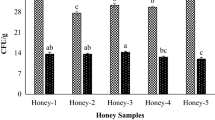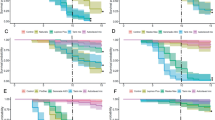Abstract
White sugar is the main commodity used to feed honey bees during the off-season as a nectar substitute. However, the price of sugar is increasing every year, thereby making bee keeping an expensive enterprise. Hence, it is necessary to find an alternative bee feed that is cheaper than sugar. The study aims to determine the potential of an alternative bee feed from renewable resources using onion waste (OW), which has a similar sugar composition to that of honey. The OW produces biosugar from in-house produced enzymes at a 90% conversion rate. The efficiency of enzymatic hydrolysis increases by more than 2 times after popping pretreatment. Furthermore, a removal rate of 98.5% for sulfur compounds, which caused the distinctive smell of onion, is obtained using a continuous column process with an activated carbon-containing alginate bead (AC-AB) adsorbent. In addition, after popping pretreatment and continuous AC-AB adsorbent column treatment, the feed intake is increased and the mortality is decreased by 3.2 times compared to that of none-popping and desulfurization treatment. Moreover, the combination of alternative feed with pollen decreases the mortality rate to almost 5.4 times. The results clearly demonstrates that OW can be a possible alternative feed source for honey bees.
Graphic Abstract






Similar content being viewed by others
Abbreviations
- OW:
-
Onion waste
- AC-AB:
-
Activated carbon-containing alginate bead
- POW:
-
Popping-pretreated onion waste
- NOW:
-
Non-pretreated onion waste
- HMF:
-
5-Hydroxymethylfurfural
- OS-I:
-
Onion sugar I
- OS-II:
-
Onion sugar II
- AF-I:
-
Alternative feed I
- AF-II:
-
Alternative feed II
References
Goulson, D., Nicholls, E., Botías, C., Rotheray, E.L.: Bee declines driven by combined stress from parasites, pesticides, and lack of flowers. Science 347(6229), 1255957 (2015)
Switanek, M., Crailshein, K., Truhetz, H., Brodschneider, R.: Modeling seasonal effects of temperature and precipitation on honey bee winter mortality in a temperature climate. Sci. Total Environ. 579, 1581–1587 (2017)
Neupane, N.R., Thapa, R.B.: Alternative to off-season sugar supplement feeding of honeybees. J. Inst. Agric. Anim. Sci. 26, 77–81 (2005)
Koo, W.W., Taylor, R.D.: Outlook of the U.S. and World Sugar Markets, 2013–2023. Center for Agricultural Policy and Trade Studies, North dakota state university (2014)
Bahran-Parvar, M., Lim, L.-T.: Fresh-Cut Onion: a review on processing, health benefits, and shelf-life. Compr. Rev. Food Sci. Food Saf. 17, 290–308 (2018)
Pereira, G.S., Cipriani, M., Wisbeck, E., Souza, O., Strapazzon, J.O., Gern, R.M.M.: Onion juice waste for production of Pleurotus sajor-caju and pectinases. Food Bioprod. Process. 106, 11–18 (2017)
Sharma, K., Mahato, N., Nile, S.H., Lee, E.T., Lee, Y.R.: Economical and environmentally-friendly approaches for usage of onion (Allium cepa L.) waste. Food Funct. 7, 3354–3369 (2016)
FAOSTAT: http://www.fao.org/faostat/en/#data/QC (2016)
French, L., Hamman, L., Katz, S., Kozaki, Y., Frew, J.: Zero waste strategies for gills onions sustainable innovation and waste management. Donald Bren School of Environmental Science & Management, University of California, Santa Barbara (2010)
Waldron, K.W.: Useful ingredients from onion waste. Food Sci. Technol. 15(2), 38–41 (2001)
Asiah, N., Djaeni, M., Hii, C.L.: Moisture transport mechanism and drying kinetic of fresh harvested red onion bulbs under dehumidified air. Int. J. Food Eng. 13(9), 1–9 (2017)
Leqande, K.E.: Onion. In: Peter, K.V. (ed.) Handbook of Herbs and Spices, pp. 417–429. Woodhead Publishing, Cambridge (2012)
Patil, V.S., Deshmukh, H.V.: Co-digestion of potato and onion market waste for biogas generation. J. Glob. Biosci. 4(6), 2532–2536 (2015)
Benítez, V., Mollá, E., Martín-Cabrejas, M.A., Aguilera, Y., López-Andréu, F.J., Cools, K., Terry, L.A., Esteban, R.M.: Characterization of industrial onion wastes (Allium cepa L.): dietary fibre and bioactive compounds. Plant Foods Hum. Nutr. 66, 48–57 (2011)
Bello, M.O., Olabanji, I.O., Abdul-Hammed, M., Okunade, T.D.: Chracterization of domestic onion wastes and bulb (Allum cepa L.): fatty acids and metal contents. Int. Food Res. J. 20(5), 2153–2158 (2013)
Sharma, K., Mahato, N., Lee, Y.R.: Systematic study on active compounds as antibacterial and antibiofilm agent in aging onions. J. Food Drug Anal. 26, 518–528 (2018)
Cebin, A.V., Šeremet, D., Mandura, A., Martinić, A., Komes, D.: Onion solid waste as apotential source of functional food ingredients. Eng. Power 15(3), 7–13 (2020)
Santiago, B., Calvo, A.A., Gullón, B., Feijoo, G., Moreira, M.T., Gonzáles-García, S.: Production of flavonoid quercetin and fructooligosaccharides from onion (Allium cepa L.) waste: an environmental life cycle approach. Chem. Eng. J. 392(15), 123772 (2020)
Choi, I.S., Cho, E.J., Moon, J.H., Bae, H.-J.: Onion skin waste as a valorization resource for the by-products quercetin and biosugar. Food Chem. 188, 537–542 (2015)
Kim, H.M., Song, Y., Wi, S.G., Bae, H.-J.: Production of D-tagatose and bioethanol from onion waste by an intergrating bioprocess. J. Biotechnol. 260, 84–90 (2017)
Khiari, Z., Makris, D.P.: Stability and transformation of major flavonols in onion (Allium cepa) solid wastes. J. Food Sci. Technol. 49, 489–494 (2012)
Turner, C., Turner, P., Jacobson, G., Almgren, K., Waldebäck, M., Sjöberg, P., Karlsson, E.N., Markides, K.E.: Subcritical water extraction and ß-glucosidase-catalysed hydrolysis of quercetin glycosides in onion waste. Green Chem. 8, 949–959 (2006)
Kaack, K., Christensen, L.P., Hansen, S.L., Grevsen, K.: Non-structural carbohydrates in processed soft fried onion (Allium cepa L.). Eur. Food Res. Technol. 218, 372–379 (2004)
Hussain, S., Joudu, I., Bhat, R.: Dietary fiber from underutilized plant resources-S positive approach for valorization of fruit and vegetable wastes. Sustainability 12, 5401 (2020)
Benkeblia, N., Onodera, S., Yoshihira, T., Kosaka, S., Shiomi, N.: Effect of temperature on soluble invertase activity, and glucose, fructose and sucrose status of onion bulbs (Allium cepa) in store. Int. J. Food Sci. Nutr. 66, 48–57 (2011)
Wheeler, M.M., Robinson, G.E.: Diet-dependent gene expression in honey bees: honey vs. sucrose or high fructose corn syrup. Sci. Rep. 4, 5726–5730 (2014)
Abou-Shaara, H.F.: Effects of various sugar feeding choices in survival and tolerance of honey bee workers to low temperatures. J. Entomol. Acarol. Res. 49, 6200 (2017)
Song, Y., Nguyen, Q.A., Wi, S.G., Yang, J., Bae, H.-J.: Strategy for dual production of bioethanol and d-psicose as value-added products from cruciferous vegetable residue. Bioresour. Technol. 223, 34–39 (2017)
Davis, F., Terry, L.A., Chope, G.A., Faul, C.F.J.: Effect of extraction procedure on measured sugar concentrations in onion (Allium cepa L.) bulbs. J. Agric. Food Chem. 55, 4299–4306 (2007)
Hagler, J.R., Cohen, A.C., Loper, G.M.: Production and composition of onion nectar and honey bee (Hymenoptera: Apidae) foraging activity in Arizona. Environ. Entomol. 19, 327–331 (1990)
Rose, P., Whiteman, M., Moore, P.K., Zhu, Y.Z.: Bioactive S-alk(en)yl cysteine sulfoxide metabolites in the genus Allium: the chemistry of potential therapeutic agents. Nat. Prod. Rep. 22, 351–368 (2005)
Waller, G.D., Carpenter, E.W., Ziehl, O.A.: Potassium in onion nectar and its probable effect on attractiveness of onion flowers to honey bees. J. Am. Soc. Hortic. Sci. 97, 535–539 (1972)
Cui, H., Turn, S.Q., Reese, M.A.: Removal of sulfur compounds from urility pipelined synthetic natural gas using modified activated carbons. Catal. Today 139, 274–279 (2009)
Park, J.J., Jung, S.Y., Ryu, C.Y., Park, C.G., Kim, J.N., Kim, J.C.: The removal of sulfur compounds using activated carbon-based sorbents impregnated with alkali or alkaline earth metal. J. Nanoelectron. Optoelectron. 5, 222–226 (2010)
Bagheri, S., Julkapli, N.M.: Effect of hybridization on the value-added activated carbon materials. Int. J. Ind. Chem. 7, 249–264 (2016)
Garcia-Galan, C., Berenguer-Murcia, Á, Fernandex-Lafuente, R., Rodrigues, R.C.: Potential of different enzyme immobilization strategies to improve enzyme performance. Adv. Synth. Catal. 353(16), 2885–2094 (2011)
Wahab, R.A., Elias, N., Abdullah, F., Ghoshal, S.K.: On the taught new tricks of enxymes immobilization: an all-inclusive overview. React. Funct. Polym. 152, 104613 (2020)
Labus, K., Wolanin, K., Radosiński, Ł: Comparative study on enzyme immobilization using natural hydrogel matrices-experimental studies supported by molecular models analysis. Catalysis 10, 489 (2020)
Wi, S.G., Chung, B.Y., Lee, Y.G., Yang, D.J., Bae, H.-J.: Enhanced enzymatic hydrolysis of rapeseed straw by popping pretreatment for bioethanol production. Bioresour. Technol. 102, 5788–5793 (2011)
Choi, I.S., Kim, J.H., Wi, S.G., Kim, K.H., Bae, H.-J.: Bioethanol production from mandarin (Citrus unshiu) peel waste using popping pretreatment. Appl. Energy 102, 204–210 (2013)
Giner Martínez-Sierra, J., San Blas, G., Marchante, O., Gayón, J.M., García Alonso, J.I.: Sulfur analysis by inductively coupled plasma-mass spectrometry: a review. Apectrochimica Acta Part B 10, 35–52 (2015)
Phisut, N., Jiraporn, B.: Characteristics and antioxidant activity of Maillard reaction products derived from chitosan-sugar solution. Int. Food Res. J. 20(3), 1077–1085 (2013)
Wheeler, M.M., Robinson, G.E.: Diet-dependent gene expression in honey bees: honey vs. sucrose of high fructose corn syrup. Sci. Rep. 4, 5726 (2014)
Karimi, K., Taherzadeh, M.J.: A critical review on analysis in pretreatment of lignocelluloses: degree of polymerization, adsorption/desorption, and accessibility. Bioresour. Technol. 203, 348–356 (2016)
Nguyen, Q.A., Cho, E.J., Trinh, L.T.P., Jeong, J., Bae, H.-J.: Development of an integrated process to produce D-mannose and bioethanol from coffee residue waste. Bioresour. Technol. 244, 1039–1048 (2017)
Haque, M.A., Yang, X., Ong, K.L., Tang, W.-T., Kwan, T.H., Kulkarni, S., Lin, C.S.K.: Bioconversion of beverage waste to high fructose syrup as a value—added product. Food Bioprod. Process. 105, 179–187 (2017)
Rashid, M.H., Taj, E., Chowdhury, H.F., Bepay, N.I., Jung, N.C.: Supplement feeding to honeybee colony for field crop pollination; pumpkin and honey production in sandbar cropping system. J. Apicult. 33, 25–32 (2018)
Javaheri, S.D., Esmaili, M., Nkkhaohi, A., Mirhadi, S.A., Tahnasebi, H.: Honeybees with protein supplement and pollen substitute and its effects on development and resistance of honeybee’s colonies and honey production. In: 7th IBRA Conf./5th AAA Conf., Changmai, Thailand, p. 76 (2000)
Acknowledgements
This research was supported by Basic Science Research Program through the National Research Foundation of Korea (NRF) funded by the Ministry of Education (NRF-2018R1A2A2A05018238).
Author information
Authors and Affiliations
Corresponding author
Additional information
Publisher’s note
Springer Nature remains neutral with regard to jurisdictional claims in published maps and institutional affiliations.
Supplementary Information
Below is the link to the electronic supplementary material.
Rights and permissions
About this article
Cite this article
Cho, E.J., Choi, YS. & Bae, HJ. Bioconversion of Onion Waste to Valuable Biosugar as an Alternative Feed Source for Honey Bee. Waste Biomass Valor 12, 4503–4512 (2021). https://doi.org/10.1007/s12649-021-01344-x
Received:
Accepted:
Published:
Issue Date:
DOI: https://doi.org/10.1007/s12649-021-01344-x




